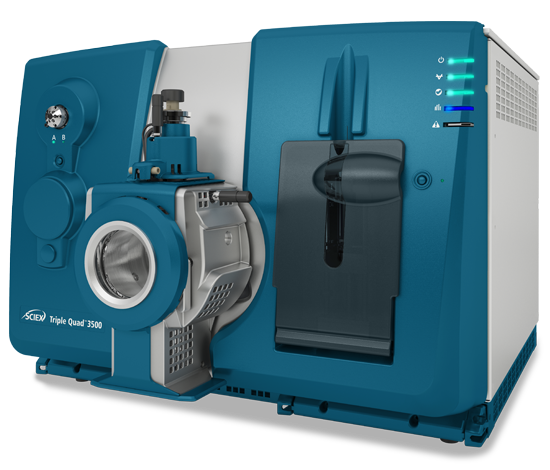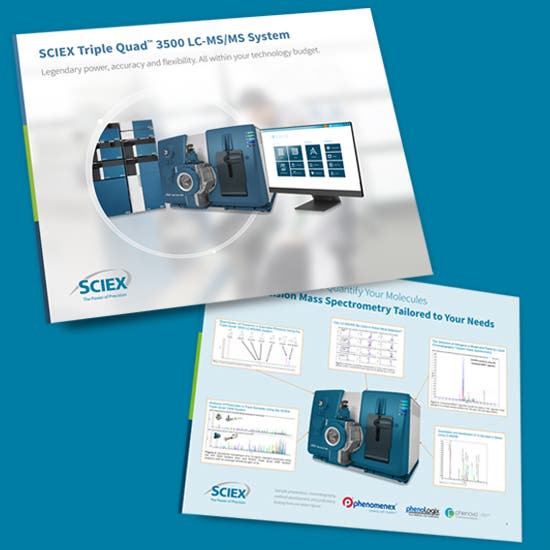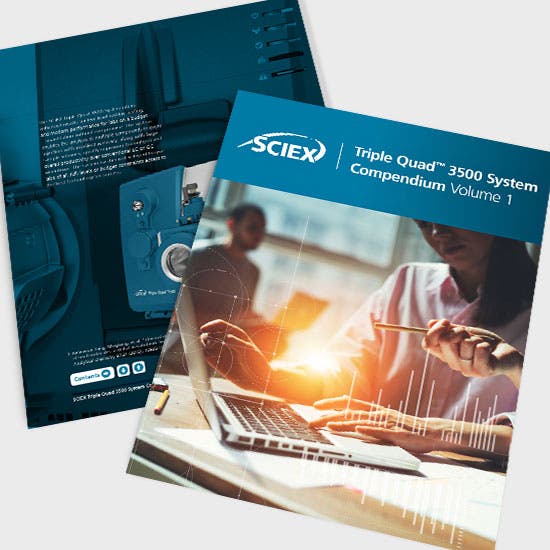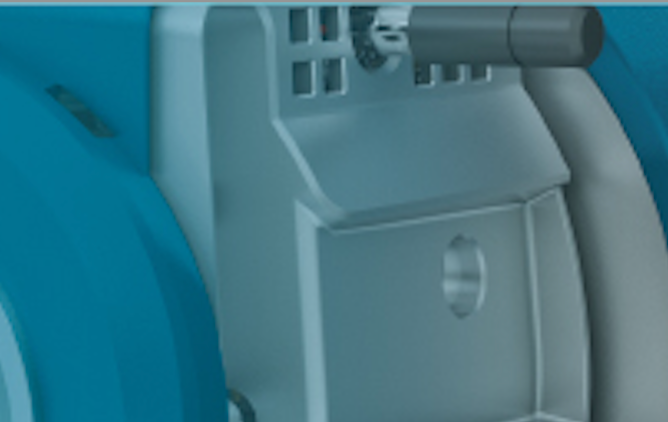If you’re currently running your assays using GC, GC-MS, or HPLC, a bold new world awaits you. Discover how the power of liquid chromatography (LC) coupled with triple quadrupole tandem mass spectrometry (MS/MS) can simplify and consolidate your current assays, dramatically increase your assay quality, and vastly expand the repertoire of assays you can provide – without breaking your budget. With the SCIEX Triple Quad™ 3500 LC-MS/MS system, modern hardware, powerful software, and robust engineering combine to enable lower levels of detection and quantitation than conventional GC and LC workflows, and across a wider range of analytes. You’ll get expert level performance at an entry level price.

SCIEX Triple Quad™ 3500 LC-MS/MS System
Status: Available Require more information? Click here
SCIEX Triple Quad 3500 System Compendium
For challenging applications requiring identification and quantification of known and unknown analytes at low concentrations, the power of LC-MS is undisputable. Download the compendium to see the powerful capabilities of the SCIEX Triple Quad 3500 System.
GC-MS vs. LC-MS/MS
Why SCIEX LC-MS/MS?
The SCIEX Triple Quad 3500 LC-MS/MS system combines the ease of liquid chromatography with its inherently broad analyte applicability, with the quantitative power of triple quadrupole tandem mass spectrometry (MS/MS).
The power of liquid chromatography for separation (LC)
Simplify sample preparation and reduce contamination
Liquid chromatography is amenable to the analysis of a wide array of analytes. In fact, many compounds that are difficult to analyze by GC such as thermally labile and chemically unstable analytes, amines, and semi-volatile compounds, are ideal candidates for LC-MS/MS. GC based assays, including GC-FID and GCMS, typically require samples to be in an organic injection solvent. This often necessitates derivatization of hydrophilic analytes to improve their volatility, ionization, or peak shape. Although usually more straightforward, HPLC-UV and HPLC-DAD assays can also involve complicated sample preparation techniques and be labor intensive depending upon the compound class. In contrast, while LC-MS/MS sample preparation methods can include solid-phase extraction or liquid-liquid extraction, they are often as simple as direct injection, dilution, or protein precipitation. By minimizing sample handling and decreasing the number of sample preparation steps, not only are areas for contamination minimized, but time is saved as well. And with today’s ultra-high performance LC systems (UHPLC), you can save even more time with ultra-fast chromatographic separations.
The power of tandem mass spectrometry for analysis (MS/MS)
Increase selectivity and improve detection limit
Mass spectrometry has been used as a powerful back-end detector for chromatographic separation techniques for over 50 years. It not only acts as a physical detection device that marks the specific retention time for your analyte, but it also provides an additional layer of specificity by providing molecular weight information on each compound. Now imagine that power intensified. With tandem mass spectrometry (MS/MS) you’ll gain yet another level of selectivity through detection of analyte-specific product ions. Through a process called multiple reaction monitoring (MRM), analyte precursor ions are selected in the first stage of analysis, dissociated into fragment ions within the second stage, and selectively filtered and detected within the third stage of analysis. Thus, by sequentially selecting and fragmenting each analyte so that only analyte-specific product ions are detected, the specificity and sensitivity of the assay can be improved exponentially. Additionally, co-eluting analytes and samples within complex matrices that may have been problematic for other assays, can greatly benefit from the additive power that MS/MS provides.
The power of a triple quadrupole for quantitation (Triple Quad)
Save time and achieve the highest assay performance
When it comes to MS/MS for quantitation, the type of mass analyzer matters. Triple quadrupole based mass spectrometers offer the best combined specifications for speed, sensitivity, specificity, dynamic range, and multiplexing capabilities for targeted quantitative MRM analysis versus any other type of mass analyzer. They are truly the gold-standard for targeted detection and quantitation . With a triple quadrupole based LC-MS/MS system not only can you achieve greater performance for many of your traditional GC and HPLC based assays, but new analytes can be added and new assays can be created, continually expanding the portfolio of services you can provide with one instrument. With LC-MS/MS, there’s an assay for every molecule
The power of SCIEX as your partner (SCIEX)
Gain peace of mind with reliable, easy-to-use instrumentation
SCIEX has built their reputation on developing high quality, robust, and reliable instrumentation that customers world-wide have come to rely upon on a daily basis. We introduced the first commercial triple quadrupole instrument almost 40 years ago and from that day forward our research scientists have never stopped innovating and advancing mass spectrometry technology. Evolved from an industry leading legacy, the budget-friendly SCIEX Triple Quad™ 3500 LC-MS/MS system contains all of the robust quality engineering you expect from the SCIEX portfolio.
Key features
Mass Range: 5-2,000 Da
| With the same wide mass range as our top-of-the-line triple quadrupole instruments, even high mass compounds will form multiply-charged ions within the range of the Triple Quad 3500 LC-MS/MS system so you don’t have to worry that you’ll miss anything. |
Ionization: Electrospray Ionization (ESI) and Atmospheric Pressure Chemical Ionization (APCI) probes included
| The TurboIonSpray probe enables electrospray ionization and is mild enough to be used for even labile compounds. For ionization of compounds that do not readily form ions in solution such as non polar compounds, the atmospheric pressure chemical ionization (APCI) probe can be used and may provide better sensitivity. |
Polarity Switching: 50 msec in MRM and Scheduled MRM modes
| Some analytes preferentially form positively charged ions and some form negatively charged ions. This can present a problem if both types exist within the same sample. With polarity switching, you don’t have to choose the polarity of your assay ahead of time. The Triple Quad 3500 LC-MS/MS system will flip back and forth between charge modes throughout your assay so you get the best sensitivity for every analyte. |
Detector Type: AcQuRate Pulse Counting CEM
| The AcQuRate™ Pulse Counting Channel Electron Multiplier combines the latest in detector technology with a pulse counting overlap correction algorithm. This means more accurate and precise ion detection over a wide dynamic range while maintaining maximum sensitivity. |
Scan Types: Q1 MS, Q3 MS, Product Ion, Precursor Ion, Neutral Loss or Gain, MRM
Targeted MRM quantitation is just one of the many scan types this powerful instrument can perform. With the 3500 Triple Quad LC-MS/MS system you can take advantage of one of the many additional scan types such as a Product Ion scan for structural determination of an unknown compound, a Precursor Ion or Neutral Loss scan to detect only compounds within a specific class that share a common structural moiety, or a Q1 or Q3 scan to simply determine the mass of a compound. Alternatively, create an assay that combines multiple different scan types for the ultimate in flexibility.
The Triple Quad 3500 LC-MS/MS system enables the analysis of more compounds in every injection, lower quantitation limits, and increased sample volume and throughput productivity over conventional GC and LC workflows.

SCIEX Triple Quad 3500 System Food & Environment Guide
See what the 3500 System can do for your food and environment workflows.
Download your guide -https://info.sciex.com/triple-quad-3500-guide

